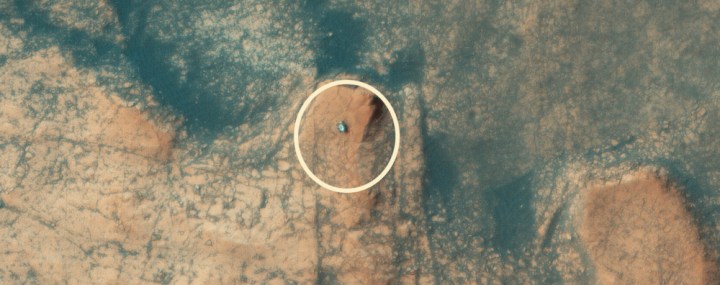
While it’s little surprise that NASA’s newest Mars rover, Perseverance, gets most of the attention these days, we shouldn’t forget that Curiosity, its other rover that arrived on the red planet in 2012, is still busy exploring the Martian surface.
Keen to remind us of the fact, the space agency recently posted a dramatic image of car-sized Curiosity captured by the Mars Reconnaissance Orbiter as it passed overhead at an altitude of around 180 miles.
The photograph shows NASA’s rover as it climbs Mont Mercou, a broad outcrop of rocks on the northern flank of Mount Sharp close to the center of the crater. As you can see, the vehicle looks tiny and isolated in its desolate surroundings …

Curiosity has been carrying out an array of scientific research on Mars for the last nine years. It’s also been sending home some impressive images from the Martian surface, including selfies, panoramas, and stunning imagery of drifting clouds.
The rover even has its own Twitter account with more than 4.1 million followers, allowing fans of its ongoing Mars mission to keep up to date with everything that it gets up to on the faraway planet.
Curiosity is located more than 2,000 miles from Perseverance, so there’s no chance of NASA’s two rovers bumping into each other. Perseverance landed on Mars in February, tasked with exploring the red planet for signs of ancient life. It also brought with it Ingenuity, a small helicopter that recently became the first aircraft to achieve powered, controlled flight on another planet, with more record-breaking flights achieved since.
NASA’s two Mars rovers were also recently joined by a Chinese rover called Zhurong, which rolled off a lander onto the surface of the red planet at the weekend.
Zhurong will explore the Martian landscape for signs of ancient life and also learn more about Mars’ environment using an array of scientific tools.
The Asian giant is getting increasingly ambitious with its space missions. Its recent arrival on Mars saw it become only the second nation to deploy a rover on the planet after the U.S., and the third to land a spacecraft there, with only the U.S. and Russia having previously achieved the feat.
Editors' Recommendations
- NASA’s Mars rover uses its self-driving smarts to navigate toughest route
- NASA’s Mars orbiter MAVEN saved in a ‘race against time’
- Watch NASA drop capsule from 1,200 feet to test Mars Sample Return system
- Moon, Mars, and more: NASA extends 8 planetary missions
- NASA marks a year since Mars drone’s historic first flight


